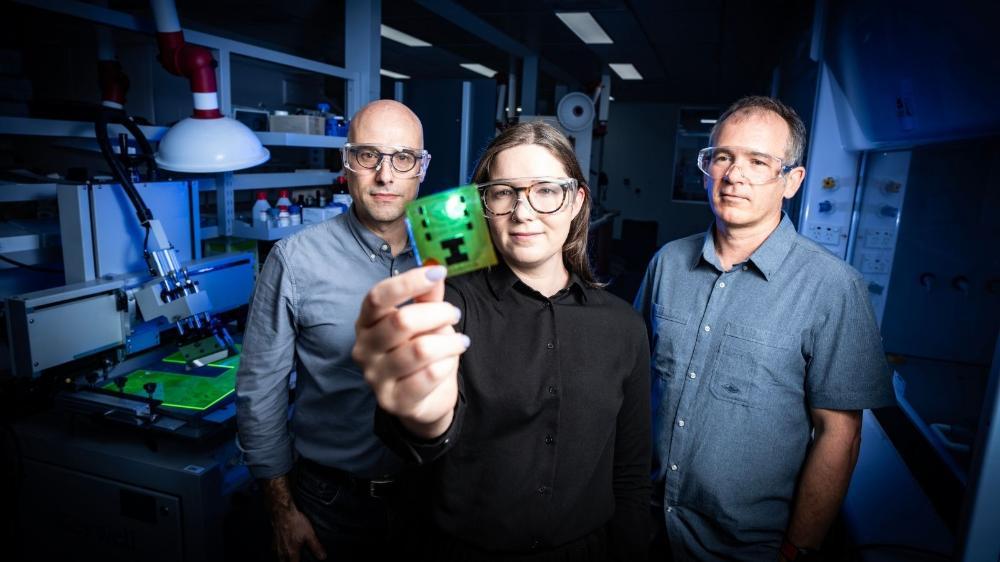November 22, 2024
Could printable organic x-ray sensors transform treatment for cancer patients?
New research shows promising signs in the effort to develop safer radiotherapy protocols
An international research team, led by the University of Wollongong (UOW), has found wearable organic x-ray sensors could be the answer towards safer radiotherapy protocols for cancer patients.
More than 400 people are diagnosed with cancer every day in Australia and 50 per cent of these people will go on to be treated with radiotherapy. The side-effects of cancer treatment, including radiation, can be debilitating.
Dr Jessie Posar from UOW’s School of Physics is leading the research team exploring the behaviour of organic x-ray sensors. Their paper ‘Flexible Organic X-Ray Sensors: Solving the Key Constraints of PET Substrates’, published today (22 November) in Advanced Functional Materials, shows promising results.
“Radiotherapy aims to use an external beam of ionising radiation to kill or damage cancer cells without damaging surrounding healthy cells or organs. This requires precise delivery of the treatment protocols to optimise outcomes and minimise side effects,” Dr Posar said.
“For example, acute skin toxicity is a common side effect and it’s experienced by 70 to 100 per cent of patients for breast cancer. So, it’s clear that the safe use of radiation in medicine is paramount to better health outcomes for Australians.”
 Professor Marco Petasecca, Dr Jessie Posar, Professor Attila Mozer and PhD Student Aishah Bashiri
Professor Marco Petasecca, Dr Jessie Posar, Professor Attila Mozer and PhD Student Aishah Bashiri
The researchers examined advancements in wearable organic x-ray sensors and found they could potentially transform future treatment options for cancer patients.
“Unlike traditional silicon-based detectors, organic semiconductors are inexpensive, lightweight, printable, stretchable and offer the first biocompatible response to ionising radiation due to their carbon-based composition,” Dr Posar said.
“These sensors can directly monitor radiation exposure of the body, allowing real-time adjustments during cancer treatments, minimising damage to healthy tissues. However, the behaviour of organic x-ray sensors is still unknown and that’s what our team wanted to explore.”
The researchers delved into the electronic performance and radiation stability of organic x-ray sensors under clinical radiation beams.
“Under conventional radiotherapy conditions we have demonstrated that organic sensors can detect incident x-rays with no dependence on the energy or dose-rate of the incoming beam, while transmitting 99.8 per cent of the beam,” Dr Posar said.
“This means it can be worn on a patient to monitor x-ray exposure without impacting treatment protocol to improve safety and clinical outcomes.”
The researchers worked with the Australia's Nuclear Science and Technology Organisation’s (ANSTO) Australian Synchrotron, one of only two places in the world developing a radiation therapy treatment modality. Termed Microbeam Radiation Therapy, the modality aims to treat otherwise untreatable tumours including brain cancer.
Dr Posar said while it has shown promising treatment outcomes, there is no detector capable of providing quality assurance, limiting treatment efficacy and patient safety.
“Our study demonstrated that flexible organic sensors can detect microbeam x-rays with a precision of 2 per cent and that they exhibit similar radiation tolerance to silicon-based detectors ensuring reliable and long-term use under these dangerous radiation fields,” Dr Posar said.
“There is still a lot of unknown physics to explore. But our work shows that organic semiconductors exhibit the ideal properties for wearable and personalised x-ray sensing to improve the accuracy and safety in oncology towards tailored radiation delivery that maximises therapeutic effectiveness and reduces harm to healthy tissues.
“This innovation could revolutionise personalised radiation therapy, offering a new level of safety and effectiveness in patient care.”
 Professor Marco Petasecca, Dr Jessie Posar, Professor Attila Mozer
Professor Marco Petasecca, Dr Jessie Posar, Professor Attila Mozer
The next stage of research will involve data science approaches to accelerate the discovery and translation to real work applications.
Dr Posar said continued international collaboration will be instrumental in current and future developments in this space. Her colleague and mentor, Professor Marco Petasecca from UOW’s School of Physics, reiterated the importance of collaboration.
“Our team has a long track record of collaboration, which reaches out nationally and internationally with the best groups in the world in the field of developing of organic sensors,” Professor Petasecca said.
“We regularly collaborate with Professor Paul Sellin at the University of Surrey; Professor Beaturice Fraboni at the University of Bologna; Dr Bronson Philippa at James Cook University; Associate Professor Matthew Griffith at the University of South Australia; the Centre for Organic Electronics and the Australian National Fabrication Facility Hub at the University of Newcastle.”
Professor Attila Mozer from the Intelligent Polymer Research Institute at UOW said being involved in this research has been an un-learning journey to discover something new.
“The performance of organic diodes exposed to natural sunlight as increased by almost 600 per cent over the last two decades, because of the work of tens of thousands of scientists and hundreds of millions of dollars in funding across the globe over that time,” Professor Mozer said.
“When we started using essentially the same materials for radiation detection, we needed to un-learn most of the well-established paradigms to make the progress we have presented today. It’s been a really fascinating aspect of this research.”
UOW PhD student Aishah Bashiri, with the thesis topic on novel radiation detectors for dosimetry in advanced radiotherapy techniques, is supervised by Dr Posar, Professor Petasecca and Professor Mozer. She is the paper’s first author.
More information
‘Flexible Organic X-Ray Sensors: Solving the Key Constraints of PET Substrates’ was published today (22 November) in Advanced Functional Materials.
This research was funded by The Office of National Intelligence Postdoctoral Grant funded by the Australian Government.
:format(jpg)/prod01/channel_3/assets/media-centre/Jessie_Posar_2024-499X281.jpg)